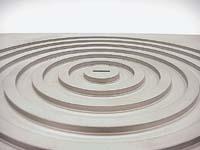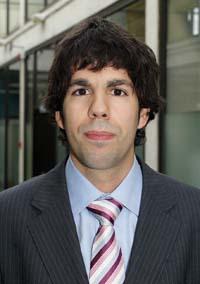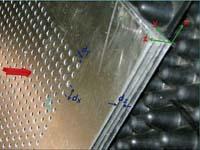Flat antennas on the roofs

The antenna designed and patented by Miguel Beruete is an aluminum foil of just over a centimeter thick, with concentric circles that can be placed on the ceiling or on the wall. The antenna can receive radio waves and microwave. These waves constitute the electromagnetic spectrum of television, mobile phones, local computer networks, wi-fi, etc.
Lower visual impact
This antenna, being flat, has a lower visual impact than the antennas that are currently commercialized. In addition, it is not very expensive, since the whole device is metal and easy to manufacture. As for the characteristics of radiation, it competes with conventional antennas, as it can be more a direction antenna or an isotrope, as desired.
An isotrope apropsa antenna, for example, will radiate equally in all directions of space. The direction antenna will radiate in one direction. The current antennas are located between both ends. In the case of flat antennas, flat antennas with isotropic or directional characteristics can be designed depending on the application to be used. For example, for mobile communications it is convenient to have an isotrope antenna that allows good coverage and the diffusion of the signal from one mobile to another. In satellite communication, however, it is advisable to concentrate the radiated power in a single point, without losing power in the other directions. Parabolic antennas are a clear example of the latter.
On the other hand, the flat antenna can contribute to alleviate somehow the saturation of the electromagnetic spectrum due to telephony signals, wi-fi (2,400 and 5,000 MHz), GPRS (890-960 MHz and 1,800 MHz), satellite television (7 and 16 GHz), etc. In these applications, the trend is clear towards high frequencies. In fact, current research tends to research and propose applications for other frequencies still not used.
Miguel Beruete, in his thesis, has worked in frequency bands of millimeter waves in a range of frequencies of approximately 30 and 300 GHz. That is, it has tried to alleviate the saturation of the electromagnetic spectrum. Flat antennas can be designed at any frequency, but the Navarrese researcher has designed antennas capable of emitting and receiving millimeter signals, since they have a higher capacity for transmitting information.
Precisely, during the study of the improvements in signal transmission, the Navarrese researcher carried out the design of flat antennas. He observed that the transmission of the signal through a small opening of a metal foil can be improved by surcs in the metal. That is the origin of the flat antennas. This phenomenon is known as an extraordinary transmission phenomenon, contrasted with optical waves. Optical waves are a set of ultraviolet, visible and near-infrared light. Well, Miguel Beruete, in his thesis, extended this phenomenon to the range of microwaves and millimeter waves, extending it to the entire electromagnetic spectrum.

Extraordinary transmission
Extraordinary transmission (ET) is a very special phenomenon. It consists of transmitting through perforated metal plates with very small openings the power of a given bandwidth, with two particularities: on the one hand, that the openings are smaller than the wavelength of the attack wave, that is, that the wave passes through minor openings than it; and on the other, that in this process the signal is reinforced.
Phenomenon of extraordinary transmission at Louis Pasteur University in Strasbourg. W. W. He was the first professor of Ebbes in 1989, in an experiment with optical wavelengths. He experimented with perforated materials and discovered that all the light coming through the holes and coming out more. But he did not seek any explanation for this phenomenon and was not published in scientific journals.
Theoretical physicist Peter Wolff explained the phenomenon of extraordinary transmission almost ten years later. Now, Miguel Berueta has experienced an extraordinary transmission between millimeter waves and has been able to prepare innovative antennas.






